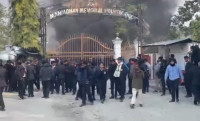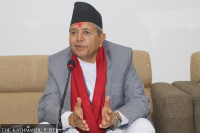National
Highly prioritised road projects are making poor progress
Many national pride projects are faltering mainly due to lack of resources and land acquisition dispute, officials say.
Prithvi Man Shrestha
The country’s long-running highly-prioritised road projects are facing implementation delays with their progress stagnating at less than 10 percent to just over 50 percent.
These include the Mid-Hill Highway, that connects Chiyo Bhanjyang of Panchthar district in the east to Jhulakhat of Bardiya district in the west, Hulaki Rajmarga (Postal Highway) connecting 20 districts in the inner Tarai region and the Kathmandu-Nijgadh Fast Track. Other major roads include the three north-south roads in the east, central and western parts of the country.
It took 12 years for the government to complete nearly 50 percent of 1,879km Mid-Hill Highway, also known as Pushpalal Highway, word on which started in the fiscal year 2007-08. It was supposed to be completed by the fiscal year 2017-18.
“The lack of resources to compensate for acquired land, the delay in completing environment impact assessment and forest clearance and the lack of timely availability of construction materials due to absence of quarry sites are among the reasons the project got delayed,” the 47th report of the National Development Action Committee (NDAC) released in February said.
By the end of the fiscal year 2019-20, the project’s progress stood at just 49 percent with 914km road being blacktopped and 84 out of 129 bridges constructed.
Only 45 percent of the total estimated cost had been spent by that period. The revised estimated cost of the project is Rs101.5 billion. Now, the government plans to complete this project by the fiscal year 2022-23.
“There wasn’t enough budget in the initial years. Work gained momentum only in the last 3-4 years,” said Shivahari Sapkota, spokesperson at the Department of Roads. “We are on course to completing the project by the revised deadline, provided the Covid-19 crisis does not affect the construction works from this fiscal year.”
Sapkota said the department planned to award tender for the remaining works of the highway and bridge construction this fiscal year.
Tulasi Sitaula, a former secretary at the Ministry of Physical Infrastructure, said the project’s progress was slow due to the government’s failure to provide adequate resources in the early years.
“We had started the work with just a few million rupees,” he said. “In the early years, we had to seek extra funds from the finance ministry due to inadequacy of resources.”
Progress of Hulaki Rajmarga has also remained sluggish. The project started in the fiscal year 2009-10, and as of the fiscal year 2019-20, only 54 percent of the work had been completed.
Of the 1,792km road, only 512km had been blacktopped and 288km had been gravelled while only 95 of the 219 bridges had been completed. The project has suffered both time and cost overruns even though it is being developed in the Tarai region where it is much easier to build roads given the plain terrain.
The project was supposed to be completed by the fiscal year 2017-18 and it was estimated to cost Rs47.27 billion. Now, the project’s deadline has been pushed back to the fiscal year 2022-23 and it is estimated to cost Rs65.20 billion. Certain sections of this highway are being built with an Indian aid of Rs8 billion.
“One of the reasons for the project delay is that the Indian contractor responsible for those highway sections being built with Indian aid fled without working on the project,” said Sapkota. “ Construction picked pace only after Nepal and India agreed to let Nepali contractors work on those highway sections.”
According to the 47th NDAC report, difficulty in getting construction materials, dispute about the border of roads in the urban built-up areas and some court cases against the construction in certain sections of the road affected the implementation of the project.
Sapkota said that the government was planning to award remaining contracts, except for the sections that fall under national park. According to him, the Covid-19 pandemic also affected the project.
The progress of the North South Corridors namely— Koshi, Kaligandaki and Karnali Corridors— has also remained poor. The construction of 162-km Koshi corridor which links Basantapur in Terhathum district with Kimathanka in Sankhuwasabha district had started in the fiscal 2008-09. The project’s progress stood at just 21 percent at the end of the last fiscal year while only 19 percent of the estimated budget of Rs16.2 billion had been spent.
Under the Kaligandaki corridor, there are two sections—Maldhunga- Ramdi-Gaidakot and Beni-Jomsom-Korala. The first section is 245km long of which only 18 percent has been completed since works started in the fiscal year 2009-10.
Likewise, only 53 percent of the road has been completed on the 186km Beni-Jomsom-Korala section. Works on the section started in the fiscal year 2016-17.
Kaligandaki Corridor Project was originally supposed to be completed by the fiscal year 2019-20. Its deadline has been extended to the fiscal year 2023-24.
When it comes to the 145km Karnali corridor, which is supposed to connect Hilsa with Salisalla in Humla district, the progress of the project stood at just 22.5 percent by the end of the last fiscal year. The project had started in the fiscal year 2012-13.
Shiva Nepal, who heads the North South Corridor Directorate, told the Post that initially there was limited fund allocation to implement these road projects.
“These projects are being implemented without setting specific deadlines with promises that there would not be shortages of resources,” he said.
According to Nepal, a detailed project report of some road sections has not even been prepared yet, track opening of sections has also not progressed due to difficult terrain.
Works on the much-talked-about 76-km Kathmandu-Nijgadh Fast Track have also failed to progress smoothly. Only 8.5 percent of the works have been completed so far.
After the initial plan to hand over the project to the Indian company—Infrastructure Leasing and Financial Services (ILFS), was cancelled in 2016, the project was handed over to Nepal Army in 2017.
The army started work on the project in the fiscal year 2017-18 and the deadline for completion has been set for fiscal 2022-23.
The Rs175 billion project is currently facing the issue of land acquisition at Khokana area in Kathmandu Valley.
Land acquisition has emerged as a problem in many road projects.
“When Mid-Hill Highway was initiated, we didn’t pay compensation for any land. People had happily accepted the project development, because the highway would increase their land value. But that is not the case everywhere. There are several lawsuits concerning compensation for land and land acquisition,” said Sitaula.




 14.12°C Kathmandu
14.12°C Kathmandu















